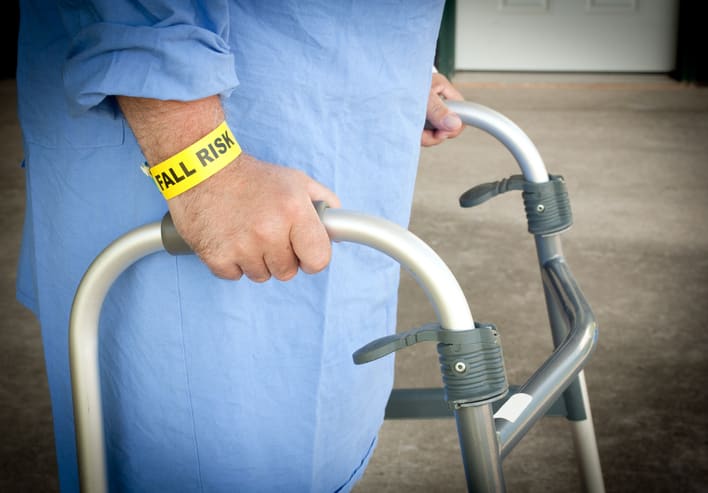
Nursing homes house some of society’s most vulnerable persons. The elderly, severely disabled, and others who do not have the capacity to live independently benefit from a residence where staff can ensure their safety and security, and attend to their needs.
Unfortunately, people in nursing homes are not immune to the types of personal injuries that can befall others outside their walls. In fact, the fragility of some nursing home residents combined with hazards within these institutions lead to a large number of falls and injuries.
In this blog post, I outline the severity of slip and fall injuries in Canada, explain why nursing homes can be a particular site of concern, and offer some tips to reduce the risk of falls.
By The Numbers
According to a 2014 report by Accreditation Canada, the Canadian Institute for Health Information, and the Canadian Patient Safety Institute, Canada spends a staggering $2 billion a year on direct healthcare costs for falls, with a total estimated economic burden of $6 billion annually. Those costs to the health care system are expected to rise dramatically as the population ages. The report, titled “Preventing Falls: From Evidence to Improvement in Canadian Health Care,” states that more than one in three senior citizens will experience a fall. Representing 85 per cent of all injury-related hospitalizations for this demographic, falls are the leading cause of injuries among older citizens and a leading cause of injury in long-term care, home care, and acute care facilities.
However, the financial cost of falls is only one aspect of their impact on society. The 2014 report notes that falls “can have a devastating physical and psychological impact resulting in disability, chronic pain, loss of independence, reduced quality of life, and even death.”
Where Slip and Falls Occur
Although most slip and fall injuries occur in and around the home, institutions such as hospitals and nursing homes also report many incidents each year.
Residential-based continuing care facilities (nursing homes) tend to report a higher rate of falls compared to hospital-based care. Approximately one-third of seniors living in homes, and half of seniors in assisted living care, suffer at least one fall per year. The number of nursing home falls leading to hospitalization among seniors is also increasing. Canada’s Public Health Agency reports that between 2006 and 2010, falls among this demographic increased by approximately 19 per cent, to 12,884 cases per year.
Research suggests the greater freedom of movement among nursing home residents, higher rates of dementia, and greater use of prescription medications for complex health conditions may partially explain this heightened risk.
Other factors affecting increased risk of falls include:
- Advanced aged
- Gender (women are more likely to suffer falls partially due to greater life expectancy)
- A patient’s previous history of falls
- Use of certain prescription medications, especially among seniors, including benzodiazepines, antidepressants, and antipsychotics
Why Do Slips and Falls in Nursing Homes Happen?
Determining the cause of falls in nursing homes can sometimes be difficult, especially if there were no witnesses to a resident’s injury. Residents may not know why they fell or might attempt to rationalize the fall as unavoidable.
However, a British Columbia study using video footage of public areas of nursing homes discovered that falls from slips are probably not nearly as common as perceived. The study found that incorrect weight shifting and trips or stumbles were the most common causes of falls. Other common causes include: transferring, hits and bumps, loss of support and collapse.
Preventing Slip and Falls in Nursing Homes
Whatever the cause, it’s clear that many slip and falls in nursing homes are preventable. Some good organizational practices include:
- Removing obstacles such as food trays, carts, and mobility devices from hallways
- Creating a cleaning schedule that minimizes the presence of wet and slippery floors during hours when residents are most active
- Being attentive to incontinence issues and promptly changing clothes and bedding to prevent at risk patients from trying to reach the bathrooms themselves
- Ensuring residents most at risk of falling are closest to nursing stations
- Providing easy access to walkers, canes and wheelchairs to assist residents with mobility
- Maintaining bed and chair alarms to alert staff when residents most at risk of falling are attempting to move
- Following proper transferring protocols depending on the resident’s needs, including ensuring bed rails are always raised when a resident is not being transferred.
- Administering the correct medications and doses on a timely schedule
When An Injury Occurs
Even if a nursing home has a fall prevention strategy in place, accidents still can happen. And, unfortunately, negligence, neglect and abuse on the part of nursing home staff or owners can contribute to or cause these personal injuries.
If you or a loved one is a resident at a nursing home and have experienced a fall resulting in serious injury – particularly one that required hospitalization – you may be eligible for compensation.
For more information on slip and fall accidents at nursing homes, please feel free to contact HSH Managing Partner and slip and fall lawyer David J. Levy at davidlevy@hshlawyers.com or 416-361-0117.






